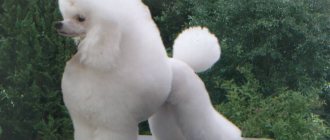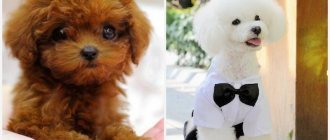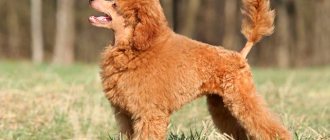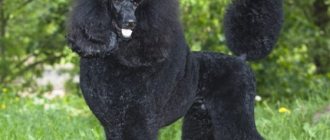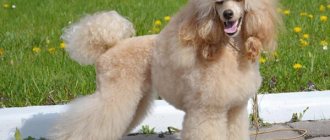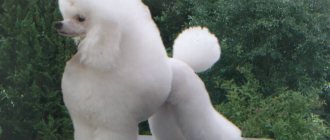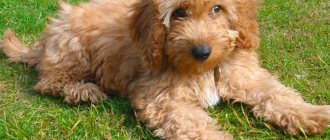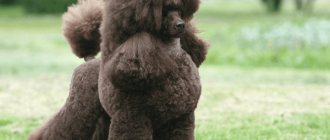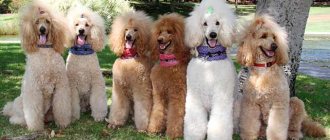Origin story
Cynologists are still arguing where the breed was bred, in France or Germany. It is officially believed that the breed was developed in France, but the word “poodle” has German roots.
Interestingly, in France dogs of this breed are called caniche. This word comes from the name of a duck, which indicates that the dog descended from hunting water breeds. The breed was officially recognized in 1955. At first it was classified as sports and service, later as decorative. Now the dog is used as a companion. But smart poodles can often be found in the circus arena or as guides for visually impaired people.
History of the breed
Rock art of poodle dogs appears on Roman tombs from the 30s BC, as well as on Greek coins dating back to the Middle Ages.
It is difficult to calculate the exact time of the appearance of the breed, but already in the 16th century these dogs were widespread throughout Europe.
Clubs in Germany and France simultaneously began developing breed standards, which is why there was a constant dispute between them about the right to be called the founder of the breed.
In 1936, Germany withdrew from the competition, and from now on France is considered the birthplace of this small dog .
Thanks to the confrontation, several completely different types of poodles appeared - aristocratic dogs from England, persistent and strong poodles from Germany, playful and mischievous French pets, etc.
The poodle is, first of all, a decorative breed of dog, created to be caressed by the love of its owners.
Description of the poodle breed
Poodles are active and playful. Among other breeds there is hardly a more cheerful and playful one.
The breed is divided into several separate species.
- Toy poodle. The smallest representative of the breed. At the withers of males it reaches only 28 cm.
- Dwarf. Slightly larger than a toy and grows up to 35 cm. This species is also called miniature.
- Small or medium. At the withers the male will grow to 45 cm.
- Royal Poodle. The largest representative of the breed, an adult male can grow up to 60 cm at the withers.
It is difficult to classify the Royal and Small Poodles as decorative breeds; they are considered sporty. The Royal and Small in the USA and Canada are used as hunting dogs for game birds and rabbits.
Toy and miniature poodles are decorative breeds and are used only as companions. The breed is loyal to its owner and easily learns any commands and tricks. The dog tolerates any climatic changes well and is suitable for keeping both in an apartment and in a house.
Another feature of the breed is that, despite the thick coat, the dog does not shed. This dog will not leave hair on furniture or carpets, making it suitable for people prone to allergies.
Description of character
Poodles are the most joyful and friendly dogs with all the inhabitants of the house. Their fur does not cause allergies, they get along with children, and bring joy to the elderly. It is a generally recognized long-liver. Some representatives of the breed live up to 18 years.
The haircut gives the animal a touch of extravagance, but underneath the external cheerful disposition hides a fragile and shy creature. The poodle is considered the most family pet. It can “forever” play with children, lie by the bed, the fireplace, or simply at the feet of its owner.
They are extremely devoted to their family, very inquisitive, and at the same time they will notify everyone with a ringing bark, guarding the territory entrusted to them. They are distrustful of strangers , and small representatives of the breed can even “pinch” a stranger for treating them familiarly. You can safely get this breed as the very first dog in your life.
Poodle breed standard (appearance)
- Body. The frame is light, with a flat back, and the body is dry.
- Head. Slightly elongated, the occipital part is pronounced.
- Muzzle. Slightly elongated. Has a smooth transition to the forehead.
- Nose. The back is straight, the nose can have a different color, depending on the color of the poodle.
- Lips. Thin, fit tightly to the mouth.
- Teeth. Scissor bite, teeth well developed.
- Eyes. Wide set, almond shaped. Color ranges from black to amber. Light and gray eye colors are not allowed.
- Paws. Developed, tall, straight. The elbows are pressed tightly to the body. In a standing position, the paws look parallel to each other; turning in any direction is not allowed. The claws are developed, the color depends on the color of the coat.
- Neck. Long, in relation to the body located at a right angle. Slightly curved when walking.
- Ears. Low set, oval in shape, hanging, close to the head. The outside of the ears is covered with long, curly hair.
- Wool cover. There are two types of coat: curly and corded. In both cases, the coat is long throughout the body, soft to the touch, and has an undercoat.
- Color. Until 2005, only black, white, apricot, silver, brown, merley, and harlequin were officially recognized. But thanks to a petition from dog breeders from many countries, the red color was officially recognized. Tan poodles are considered substandard and are discarded. The brindle color is an unofficially recognized one, and in many countries such puppies are not culled.
- Tail. Until 1999 it was stopped. Today, undocked, raised high and tilted to the side is acceptable. At the owner's request, it is docked only at ½.
Distinctive features
The main positive distinctive feature of the breed can be considered variability. Poodles have several types of colors, two types of coat and four growth varieties:
- The Large Royal Poodle is the breed standard (45-60 cm);
- Small Poodle (35-45 cm);
- Miniature Poodle (28-35 cm);
- Toy poodle (up to 28 cm).
All subspecies belong to the same standard and have the same proportions.
The latest breed standard was published in 2007, when a new shade of coat was recognized - red. Only high-quality puppies that do not have deviations in external characteristics are selected for breeding.
- The head is not refined, wedge-shaped, not too large, light. The brow ridges, stops and occipital protuberance are prominent.
- The muzzle is wide and long, rounded at the end. The bridge of the nose is straight. The jaw is strong with a full set of teeth. Scissor bite (the upper teeth overlap the lower teeth). The lips are dense and thin.
- The nose is large. The color depends on the coat color.
- The eyes are slanted, almond-shaped, set wide apart at stop level. Color – black or brown.
- The ears are set high, drooping and close to the head. Long and thin.
- The body is strong and fit with a flat back line, a wide loin and a high croup (at the line of the withers). The chest is wide and deep. The neck is short, without dewlap, with a convex nape. The stomach is tucked.
- The tail is long and set high. Carried elevated, shaped like a sickle. Cupping is permitted in countries where the law does not prohibit it.
- The limbs are long, parallel, set straight and not too wide. The paws are rounded and collected. The gait is light and springy.
- The coat can be of two types: curly (uniform springy curls) or corded (long curls).
- Colors: apricot, red, gray, white, black, peach.
Character traits
The poodle is an active breed, but despite its mobility, it is mentally balanced and calm. Breeders highlight the following character traits of the breed.
- The dog loves children and is attached to the family. Doesn't play favorites, treats owner and all other members well.
- The dog is playful and loves active games: jumping over a barrier, playing with a ball or catching a plate.
- The dog willingly makes long walks or runs with its owner.
- Thanks to its long and thick coat, it is not afraid of wind, snow, rain and drafts.
- Be suspicious of strangers unless they are children. At first he growls at an adult, but if he sees that the owner treats the stranger well, he loses interest in the object.
- One of the easiest breeds to train and suitable for novice dog owners.
- Miniature and toy poodles can easily learn to go to the toilet using a disposable diaper or in a litter box and do not need to be walked in bad weather.
- Royal and Miniature Poodles can be kept outside but are not suitable for chaining.
- The poodle's playfulness is evident towards other animals. A dog will chase an unfamiliar cat or birds, but only out of curiosity to play with them. Treats pets well.
- This is a non-aggressive breed, and even cables are rarely the first to get into fights with other dogs. Miniature and toy poodles should be protected from other large breeds.
- They have a keen sense of smell, so they are used abroad by customs to search for explosives and drugs.
- The curly dog is an excellent swimmer and loves open bodies of water and will willingly reach into the river for a ball or stick.
Poodles love attention and are not suitable for a person who is rarely at home. Without attention and communication, the dog begins to feel sad and depressed.
Care and maintenance of the Poodle
Despite the long and thick coat, caring for a poodle does not require much time, but it is better to be prepared for the financial costs. The dog's coat is trimmed regularly. There are many options for grooming your dog. The wool can be picked up, braided and hardened with multi-colored hairpins. Grooming a dog can be done at home or with the help of a special groomer. Haircut price from 1,500 rub. This is an additional expense, since the dog is cut at least once every three months.
The rest of the time, the hair is combed out, since its structure is soft and without care, mats will form on the dog. If the wool has gathered into a tangle, it is combed out. Once every few months, the dog is washed with special detangling shampoos or simple baby shampoo. After washing, the wool is dried with a hairdryer, since it will take a long time for the “fur coat” to dry on its own, and this increases the likelihood of developing fungal diseases on the skin.
The dog's nails are trimmed every 2-3 weeks. In the summer, the claws wear off on the asphalt and the procedure is carried out less frequently.
Particular attention should be paid to the animal’s ears. Poodles have a predisposition to ear diseases, so when grooming, do not forget to pluck the hair from the ear.
Features of care
A pet needs proper care, only then will the animal be cheerful, healthy and able to please its owners with its behavior and mood.
The miniature poodle, like no other, requires care and attention, but caring for him is not at all difficult.
The miniature poodle does not hesitate to attack any offender; it is one of the most loyal breeds, which demonstrates its ability to protect loved ones by any effort.
Combing
Because toy poodles have thick coats, they require occasional bathing and grooming .
Poodles generally love to take warm baths, so this is not a problem.
The best option is to bathe the dog 3-4 times a month, but if necessary, you can do it more often.
But on a pond, you shouldn’t allow your poodle any special liberties; after such fun, the fur will become matted and it will be problematic to put it in order.
Brushing with a Furminator is a daily procedure that these little dogs love so much.
Gentle rhythmic movements with a stiff brush along the hair growth provide skin massage and increase the silkiness of the coat.
Miniature Poodles get along well with other pets
The dog’s thick hair allows you to experiment with the look and change your pet’s haircut quite often.
The most popular haircuts for a miniature poodle using a clipper :
- “Scandinavian lion” - a lush mane, paws and the tip of the tail, the rest of the body is designed in smaller volumes;
- “Continental” - a lion’s mane together with wool bags on the paws and the tip of the tail, the rest of the body is shaved almost bald;
- “modern” is a simplified type of “continental” without a lush mane, this is a home option, and it is not always relevant for an exhibition;
- in the hot season, the poodle will be grateful to the owner for a haircut; such an image will not in any way affect the quality of the new coat.
Poodles love to be brushed. They are wildly delighted by the rhythmic movements of the brush over the fur.
Nutrition
The process of feeding a pet should be approached responsibly, since this breed does not welcome frequent changes in diet and requires balanced and high-calorie food.
You can buy a toy poodle ready-made dog food , but he will not refuse home-cooked food.
For this breed it is recommended to use:
- different types of meat - chicken, beef, veal;
- cereals – rice and buckwheat;
- sea fish (necessarily without bones);
- vegetables (potatoes and legumes are prohibited);
- sour milk;
- vegetable oils;
- eggs;
- fruits.
But sweets and baked goods are contraindicated for poodles; as a treat, it is better to take ½ teaspoon of natural honey.
The dwarf poodle is characterized by high intelligence and aristocratic habits
Poodle health
The poodle has good immunity and rarely gets sick. A puppy up to a year should be protected from viral and bacterial pathologies: distemper, hepatitis, enteritis. Vaccination is carried out with a complex preparation, so the dog will receive less stress from visiting the clinic. You can take your puppy for walks two weeks after the last vaccination.
Poodles are prone to the following pathologies:
- Skin diseases - eczema, dermatitis, staphylococcus. Associated with improper care of the dog's coat. Diseases are treated with special ointments and antibiotics;
- Eye diseases - conjunctivitis, cataracts;
- Knee dysplasia;
- Obesity - Poodles are prone to overeating and, without control from the owner, quickly gain excess weight. Daily exercise is used as a preventive measure;
- Allergies - mainly caused by improper feeding.
The poodle is a long-liver and, with proper care, will live at least 15–16 years. Miniature and toy poodles live even longer. Large royal ones are 2–3 years shorter.
Important! The puppy's parents must have health tests and relevant certificates - screening dogs for prolapse of the stifle (PL), eye screening for PRA, cataracts and other diseases.
Development table
Weight gain and growth of each puppy is individual. However, the owner is guided by the average indicators for the breed - excessive deviation from them should be a reason for a visit to the veterinarian.
| Age (months) | Weight, kg) | Height (cm) |
| 1 | 0,6-0,7 | 12-13 |
| 2 | 1-1,2 | 15-16 |
| 3 | 1,3-1,6 | 18-19 |
| 4 | 1,7-1,9 | 20-21 |
| 5 | 2-2,2 | 22-23 |
| 6-12 | 2,3-2,5 | 24-25 |
Parameters of an adult toy poodle:
- Height at withers: 25-28 cm.
- Weight: 2.5-3 kg.
There are also very small toys: up to 22-24 cm tall, weighing up to 2 kg. Breeders do not recommend inexperienced owners to have such miniature animals. These dogs require close attention and special conditions of detention, as they are susceptible to a number of diseases, including genetic ones.
Training
The breed easily remembers the most complex commands. Dog training can begin as soon as the puppy gets used to the new place and name. Puppy training takes place in a playful way. At home, it is recommended to teach the animal basic commands: come to me, ew, walk. These commands will help while walking the dog and are enough to start training in special OKD courses. During the basic training course, the pet will learn to follow the owner’s commands, which are given not only by voice, but also by signs. The dog learns commands: place, next to, sit, lie down, stand.
Read:
- beautiful nicknames for dogs;
- Russian nicknames for dogs.
Poodles are quite good-natured and rarely need training in ZKS courses. But royal poodles are used to guard private homes, since the weight of an adult male can reach 30 kg. Without training, a dog of any size will bark at the sight of a stranger and will definitely warn its owners.
Training and education
Poodles have an innate ability to train and learn. It is not for nothing that poodles are so often used in circus performances. Education and training in the life of these animals are not just mandatory - they bring real pleasure to a healthy dog. This is especially true for young poodles or puppies, who are ready to obediently carry out their owner’s commands for hours on end, consciously honing their skills.
Below you can read the list of rules that you need to follow if you want to train a healthy and smart poodle.
- Start training almost from birth. It is at this age that the animal best remembers all the rules and regulations. Training an adult pet may not be so simple.
- Every pet should have its own name. It will serve as a kind of guide for the pet. If you use your pet's name with specific commands regarding a situation, he will be more likely to remember them.
- There should be no violence in teaching. Avoid shouting and open aggression towards pets - they feel it wonderfully. Instead, be patient and use encouragement. For each perfect trick, treat the poodle with a small treat, gently praise it, or simply pet it.
- Designate closed and open areas immediately. There should be no concessions in visiting closed places and rooms. As soon as the animal crosses the border, immediately return it back.
- Get your poodle accustomed to grooming procedures. The less the pet twitches during such procedures, the calmer both you and him will be. That is why it is worth starting procedures from birth.
- Only one owner must train an animal. It will be difficult for your pet to get used to a large number of even identical commands from different trainers, because they will be spoken with different placement and intonation.
- After completing the basics, move on to training the rest of the teams. The simplest commands to learn should be: “near”, “to me”, “sit”, “voice”. Don't forget about the incentive method.
- Systematicity. Classes should be held regularly, at the same time. Give them at least an hour a day. After passing the next stage in training, sometimes return to the old material to consolidate.
Feeding a poodle
Since the poodle is prone to overeating, the portion size is controlled. You should not feed your animal baked goods or confectionery products. Natural food, mixed food and dry food are suitable for poodles.
For poodles on dry food, the following brands are recommended: Purina ONE, Royal Canin Gastro Intestinal, Hill's Metabolic, Pronature Holistic. Suitable brands for animals with sensitive digestion and for dogs with long hair.
The serving size for an adult dog depends on the type of poodle:
- royal - up to 3 liters;
- small - up to 1.5 liters;
- dwarf - up to 500 ml;
- that - up to 300 ml.
An adult dog is fed twice a day. Puppies under 3 months of age need feeding every 3-4 hours. From 4 to 6 months, the dog is switched to three meals a day. From 6 to 8 months, the puppy should switch to the diet of an adult dog.
The poodle's diet includes the following foods:
- cereals: buckwheat, rice, rolled oats;
- lean meat;
- offal: tripe, stomach;
- cartilage tissue: ears, tails;
- fermented milk products: cottage cheese, kefir, yogurt without dyes.
Vitamin complexes are added to the diet of a natural dog. The following brands are suitable for the poodle: Excel from the manufacturer 8 in 1, Kanvit Biotin, Doggy's Biotin from Beafar.
https://youtu.be/eQbiXC4NKO4
Photo of a poodle
In the photo, the most common and easily soiled poodle color is white. A dog with such fur looks royal, but requires more care.
The unusual cord-like dog has a coat more reminiscent of an African braided hairstyle.
The red coloration was recently recognized as official and looks unusual, especially on toy poodles.
Reviews from owners and breeders
Alexander: “A miniature poodle is suitable for a small apartment. The breed loves children and takes part in all games. Despite its small size, the dog does not like to sit on your lap for a long time. He gets bored without the attention of his owners.”
Marina: “The breed has digestive problems. In 70% of cases, the dog is predisposed to food allergies. This must be taken into account when choosing a diet; it is better to feed with special foods that already contain vitamins and minerals.”
Alena: “The breed is suitable for any family. This is the only breed that can be selected by size. The puppy quickly learns commands, and the dog remembers them for a long time. The dog is active and attached to its family, without attention it becomes depressed.”
Health
Characteristic diseases
Mischievous and overly active dogs require special care, because without it they are susceptible to numerous diseases.
The main ailments can be called:
- epilepsy;
- deafness in 1 or both ears;
- cardiac disorders;
- diabetes;
- retinal atrophy;
- autoimmune anemia;
- tearfulness;
- ear infections.
But allergies and eye diseases such as cataracts .
Because toy poodles have thick coats, they require occasional bathing. Poodles usually like to take a warm bath, so this is not a problem.
Where to buy a puppy
A purebred poodle puppy can be purchased through kennel clubs or in specialized nurseries. Puppies from the kennel have already been vaccinated and treated for parasites. Each dog is accompanied by documents in the form of a puppy card. In the future, the breeder will exchange the card for the dog's pedigree.
Among the famous nurseries, several stand out.
In Ukraine:
- "Alma Unica" - https://alma-unica.jimdo.com. They are engaged in breeding toy poodles.
- “An Ordinary Miracle” - https://obyknovennoe-chudo.jimdo.com. They specialize in breeding miniature and silver toy poodles.
In Russia:
- "Ansvel" - https://ansvel.jimdo.com. They specialize in breeding red, apricot and brown poodles.
A poodle of any size will become a true friend and companion. But the breed requires care for thick and curly hair; cutting and combing take time and require financial investment; not everyone is ready for this. And the dog becomes attached to the owner and is very worried about parting with him. Before buying a puppy, weigh the pros and cons again, and choose a poodle not according to the size of your apartment or house, but according to your liking.
How to choose a puppy
When choosing a black poodle puppy, it is very important to pay attention to the appearance and behavior of the baby, regardless of the category - whether you choose a royal (large) or a toy poodle.
Important! The pigmentation of the nose, gums, lips, palate, as well as eyelids, natural openings, including the scrotum and paw pads, should be uniform, well colored and only black.
It is not recommended to immediately adopt a puppy you like at first sight. You need to observe the litter as a whole. This rule especially applies to miniature (dwarf) and toy poodles. The activity of the puppy determines its further development. By choosing the weakest, smallest of the litter, you simply risk losing the baby in the first month of life. Look into the eyes and under the tail - everything should be dry and clean.
Watch how dog children play and go to the toilet. Meet the parents . This way you will know the approximate size of the puppy when he grows up. Ask for health certificates from the litter's parents. There is no need to pay special attention to the mother's appearance. After childbirth, girls return to their original shape for a long time. It is important to see the children's father.
And don't ignore the breeder. If he is too fussy, refuses to provide documentation, citing the long process of preparing certificates, or makes excuses that he did not attend exhibitions, and the mating took place for the sake of mommy’s health, run away from there. Look for a breeding farm where they will provide you with a full package of documents about the origin of the litter.

